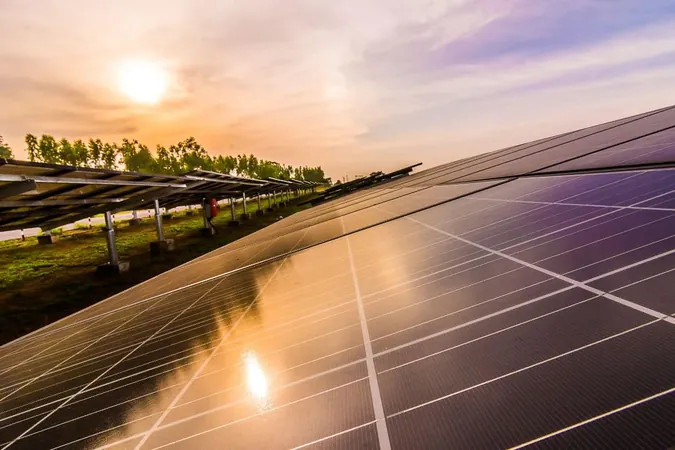
Revolutionary Discovery: Moon Dust Could Power Future Lunar Bases!
2025-04-05
Author: Yan
Exciting news from the world of space exploration: scientists have unveiled a groundbreaking method that could allow future lunar bases to harness energy directly from Moon dust! This innovative technique revolves around the creation of solar cells from simulated lunar regolith, marking an extraordinary advancement in how we envision energy logistics on the Moon.
What is Moonglass? A Game-Changer for Energy Efficiency!
The study, published on April 3, 2025, in the journal Device, introduces a novel approach where scientists transform anorthositic regolith—commonly found in the Moon’s highlands—into a specialized material known as moonglass. This moonglass will serve both as the substrate and protective layer for high-efficiency perovskite-based solar cells, promising to minimize dependence on Earth-derived materials by an astounding 99%! Current solar cells in space boast impressive efficiencies of up to 30-40%. However, they come with hefty costs and require heavy materials that pose challenges during launch. Felix Lang, lead researcher at the University of Potsdam, points out, “While these solar cells are state-of-the-art, their efficiency is matched by their expense and bulk.
The Incredible Benefits of Harnessing Moon Dust
Instead of relying on expensive terrestrial resources, Lang and his team cleverly utilized lunar regolith. By transforming this rocky material into moonglass, they revolutionized the solar panel's construction. This breakthrough innovation could drastically reduce the launch weight of solar panels by an astonishing 99.4%, slashing transport costs and paving the way for more practical long-term lunar settlements.
How Does It Work? The Science Behind Moonglass Solar Cells
Researchers melted simulated Moon dust to create moonglass and paired it with perovskite—a class of low-cost, highly efficient crystals that excel in converting sunlight into electricity. The result is solar cells that can produce up to 100 times more energy for each gram compared to traditional Earth-made solar panels. Lang states, “With a 99% reduction in weight, we don’t have to stick with ultra-efficient 30% solar cells; instead, we can manufacture more of them directly on the Moon.”
Superior Resistance to Space Radiation!
One of the critical advantages of moonglass is its inherent resistance to the damaging effects of space radiation. Conventional solar cells often degrade over time in the harsh lunar environment, diminishing their effectiveness. In contrast, moonglass cells are naturally infused with properties that prevent radiation-induced degradation. The brown tint from lunar dust impurities enhances stability and maintains efficiency in sunlight exposure.
What Lies Ahead: Challenges and Future Prospects
While this breakthrough brings us closer to sustainable lunar energy, several challenges remain. The Moon's lower gravity may affect the formation of moonglass during production, potentially altering its properties. Furthermore, the Moon's extreme temperature variations, soaring over 100°C during the day and plunging below -170°C at night, could pose threats to long-term durability. Chemical reactions also present hurdles, as typical solvents used in perovskite processing on Earth may not react well in the Moon's vacuum environment. Nevertheless, the research team remains optimistic and is actively preparing for a small-scale demonstration mission to test the solar cells under real lunar conditions.
The Future of Lunar Exploration is Bright!
With this revolutionary approach, not only could we envision thriving lunar colonies, but we may also be taking significant steps toward sustainable energy solutions for future space missions. The sky is not the limit anymore; the Moon is just the beginning! Stay tuned for more groundbreaking updates from the field of space exploration.





 Brasil (PT)
Brasil (PT)
 Canada (EN)
Canada (EN)
 Chile (ES)
Chile (ES)
 Česko (CS)
Česko (CS)
 대한민국 (KO)
대한민국 (KO)
 España (ES)
España (ES)
 France (FR)
France (FR)
 Hong Kong (EN)
Hong Kong (EN)
 Italia (IT)
Italia (IT)
 日本 (JA)
日本 (JA)
 Magyarország (HU)
Magyarország (HU)
 Norge (NO)
Norge (NO)
 Polska (PL)
Polska (PL)
 Schweiz (DE)
Schweiz (DE)
 Singapore (EN)
Singapore (EN)
 Sverige (SV)
Sverige (SV)
 Suomi (FI)
Suomi (FI)
 Türkiye (TR)
Türkiye (TR)
 الإمارات العربية المتحدة (AR)
الإمارات العربية المتحدة (AR)